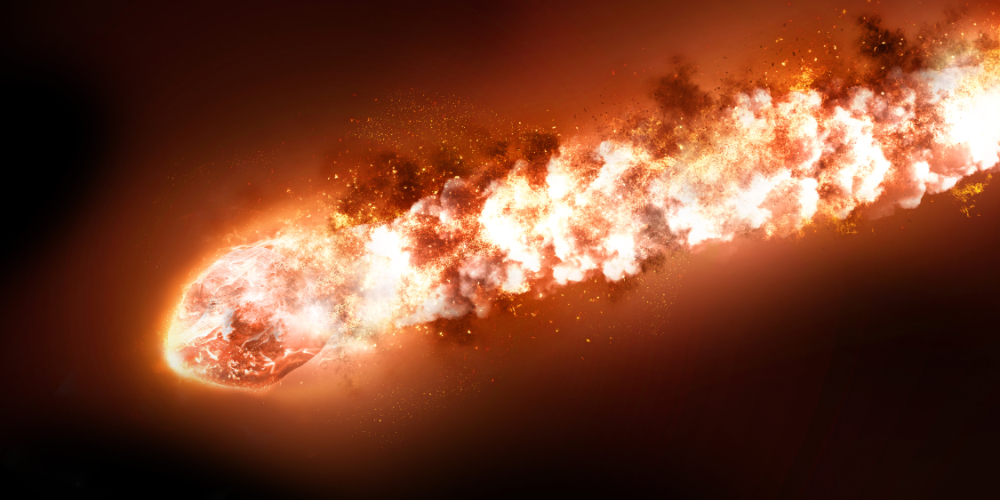How on Earth??
Water and its impossible meteorite delivery

Water is one of the simplest, yet most precious substances on Earth. Water is required for human growth, reproduction, digestion, perspiration, lubrication, excretion, and countless other functions in all living creatures. Its molecular formula (H2O) is so simple and common, that it is one of the very first chemical formulas that most children will learn. More than 70% of the earth’s surface is covered in water and it is one of the greatest gifts of God’s creation.
From an atheistic and evolutionary perspective, however, where did all this water come from? According to the Smithsonian, “It took an out-of-this-world arrival to get that perfect chemical combination for water to fill our planet.”1
In an ever-increasing attempt, from a 13.8-billion-year ‘big bang world view’, scientists from organizations like the Smithsonian try to explain how the life-giving and life-sustaining substance of water came to the earth without a Creator God. “Water molecules were surely part of the dusty swirl that coalesced into the Sun and its planets beginning about nine billion years after the Big Bang.”1
This is not only a bald assertion, there is no possible way to prove such a claim. As well, there is no explanation of the origin of this ‘perfect chemical combination’ and it is assumed that it just ‘happened’. According to the Smithsonian, the water came to Earth via comets and asteroids (the latter become classified as meteorites upon hitting the earth) in a symphony of choreographed hits. And “such bodies (probably more asteroids than comets) could easily have delivered oceans’ worth of water.”1 The Smithsonian simply declares that these cosmic agents provide the easy answer to this seemingly difficult question. And then as a concluding touch, “so, the next time you turn on the tap, think of the flowing water’s long and wonderful journey.”1

Trillions are required!
Is this seemingly simple explanation really possible? How big would these cosmic visitors have to be? And how many direct hits to Earth would it actually take to “easily deliver an oceans’ worth of water”? The numbers turn out to be staggeringly impossible!
The starting point for these calculations begins by establishing how much water is actually on the earth. Based on the surface area of water on Earth and its average depth, a conservative estimate is about 1.386 × 1021 litres or 1.386 billion cubic km3.2 This number is staggering in itself.
The large supertankers used to transport massive amounts of liquids (usually crude oil), can hold on average about 125 million litres (33 million US gallons).3 If the average amount of water4 were a very generous 10% on every water-containing meteorite, and every meteorite were 10 times the size of a supertanker, a minimum number of 11.1 trillion meteorites would be required for this delivery service!
Understanding this (if that is even possible), and if the earth really is 4.6 billion years old, it would take an average of 2,410 direct meteorite strikes every year (that is 46 hits per week) for 4.6 billion years in a row! (If the meteorites were 100 times smaller, then the number of hits required would increase to 4,600 per week). It is also assumed that no water is lost into space as a result of its fiery entry through the atmosphere.
So, what would the earth look like if it had actually been pummelled 46 times a week for 4.6 billion years by super-tanker-sized objects? Consider that the Barringer Crater in Arizona was formed by a meteorite hit that caused a 1.2 km diameter crater that is 180 metres deep. This enormous hole, however, was caused by a meteorite that was an estimated 40 meters in diameter,5 more than 10 times smaller than a supertanker and 100 times smaller than our estimated cosmic visitors. The amount of energy released in the Barringer Crater hit was equivalent to 2.5 million tonnes of TNT, which is 150,000 times more powerful than the atomic bombs dropped on Hiroshima and Nagasaki, Japan, at the end of World War II.5
An impossible conjecture
Just one massive supertankersized meteorite hit of the 11.1 trillion required would be 750,000 times the power of a Hiroshima bomb! It would cause such cataclysmic damage, the effect on life on Earth would be nothing short of catastrophic. Much smaller presumed impacts have been shown to cause a ‘nuclear winter’, one of which is speculated by long-agers to have wiped out all dinosaurs. For life to survive, let alone evolve to its present state, under such a scenario (46 of these a week with a total of trillions) is such a bizarre proposition as to comfortably be regarded as impossible. No such trillions of cosmic visitors ever delivered the vast volumes of water found on our planet. This impossible theory is dead before it even starts.
The rational and plausible explanation of the origin of Earth’s water is clearly set out in Genesis, where God creates an earth covered in water on Day 1 of Creation Week. Only an all-powerful, all-knowing creator God could speak and create this enormous amount of life-sustaining water for our planet.
References and notes
- Greene, B., How did water come to Earth? It took an out-of-this-world arrival to get that perfect chemical combination for water to fill our planet, smithsonianmag.com, May 2013. Return to text.
- How much water is there on Earth, usgs.gov, accessed 14 Aug 2019. Return to text.
- Tanker Sizes and Classes, transportgeography.org, accessed 24 Jul 2019. Return to text.
- Mostly in frozen form while travelling in deep space. Return to text.
- Barringer Impact Crater—Stop 1, Planetary Science Institute, psi.edu, accessed 24 Jul 2019. Return to text.






Readers’ comments
Comments are automatically closed 14 days after publication.